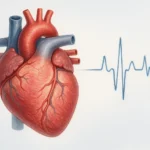
Nasal Cancer in Dogs: Comprehensive Guide for Pet Owners
- Understanding Nasal Cancer in Dogs
- Diagnostic Procedures
- Treatment Options
- Staging and Disease Progression
- Common Nasal Tumor Types in Dogs
- Prognosis and Expected Outcomes
- Importance of Early Intervention
- Managing Side Effects of Treatment
- Supportive Care and Quality of Life
- Recurrence and Long-Term Monitoring
- When to Euthanize a Dog with Nasal Cancer
- Alternative and Integrative Therapies
- The Owner’s Role in Daily Support
- Misconceptions and Common Mistakes
- Final Thoughts: Balancing Hope and Realism
- FAQ
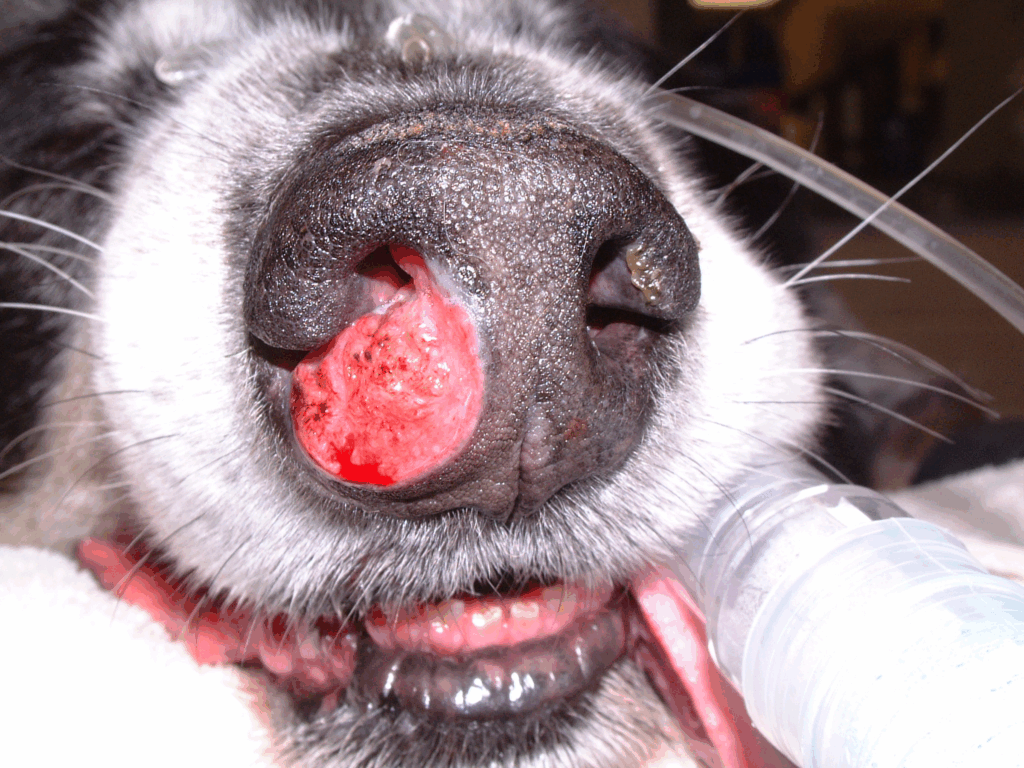
Understanding Nasal Cancer in Dogs
Nasal cancer in dogs refers to malignant tumors that develop within the nasal cavity or surrounding structures. These tumors can be aggressive and locally invasive, leading to significant discomfort and health issues for affected dogs. The most common types of nasal tumors in dogs include carcinomas (such as adenocarcinoma and squamous cell carcinoma) and sarcomas (including fibrosarcoma and chondrosarcoma).
The exact cause of nasal cancer in dogs is not well understood, but factors such as environmental pollutants, exposure to tobacco smoke, and genetic predisposition may contribute to its development. Long-nosed breeds like Collies and Greyhounds are more commonly affected, suggesting a possible anatomical predisposition.
Recognizing Early Symptoms
Early detection of nasal cancer significantly improves treatment outcomes. Common early signs include persistent nasal discharge (which may be bloody), sneezing, noisy breathing, and facial swelling. As the tumor progresses, dogs may exhibit more severe symptoms such as difficulty breathing, loss of appetite, weight loss, and lethargy. In advanced cases, neurological signs like seizures can occur if the tumor invades the brain.
It’s essential to consult a veterinarian if your dog exhibits any of these symptoms, as early diagnosis and intervention can lead to better management of the disease.
Diagnostic Procedures
Diagnosing nasal cancer in dogs involves a combination of clinical evaluation and diagnostic tests. A thorough physical examination is the first step, followed by imaging studies such as X-rays, CT scans, or MRIs to assess the extent of the tumor. Rhinoscopy, which involves inserting a small camera into the nasal passages, allows for direct visualization and biopsy of the tumor. Histopathological examination of the biopsy sample confirms the diagnosis and helps determine the specific type of cancer.
Early and accurate diagnosis is crucial for developing an effective treatment plan and improving the prognosis for affected dogs.
Treatment Options
Treatment for nasal cancer in dogs depends on factors such as the type and stage of the tumor, as well as the overall health of the dog. Radiation therapy is the most common and effective treatment, often resulting in significant tumor reduction and symptom relief. Surgical removal of the tumor may be considered in certain cases, although the complex anatomy of the nasal cavity can make complete excision challenging. Chemotherapy may be used in conjunction with other treatments, especially for certain types of tumors like lymphoma.
Supportive care, including pain management and anti-inflammatory medications, plays a vital role in maintaining the dog’s quality of life during treatment. Regular follow-up visits are essential to monitor the dog’s response to therapy and adjust the treatment plan as needed.
Staging and Disease Progression
Veterinarians use staging systems to evaluate how far nasal cancer has advanced in dogs, which directly impacts the prognosis and guides treatment decisions. Most staging relies on imaging results, especially CT scans, to assess local invasion, bone involvement, and possible metastasis to regional lymph nodes or lungs.
Stage 1 typically indicates a tumor confined to one side of the nasal cavity without bone involvement. Stage 2 includes bone destruction within the nasal cavity, while Stage 3 shows invasion of tissues around the eye or the orbit. Stage 4 involves spread to the cribriform plate or beyond, potentially reaching the brain.
The earlier the cancer is identified, the better the treatment outcomes. Unfortunately, because many symptoms mimic common infections or allergies, diagnosis is often delayed until the tumor is already advanced.
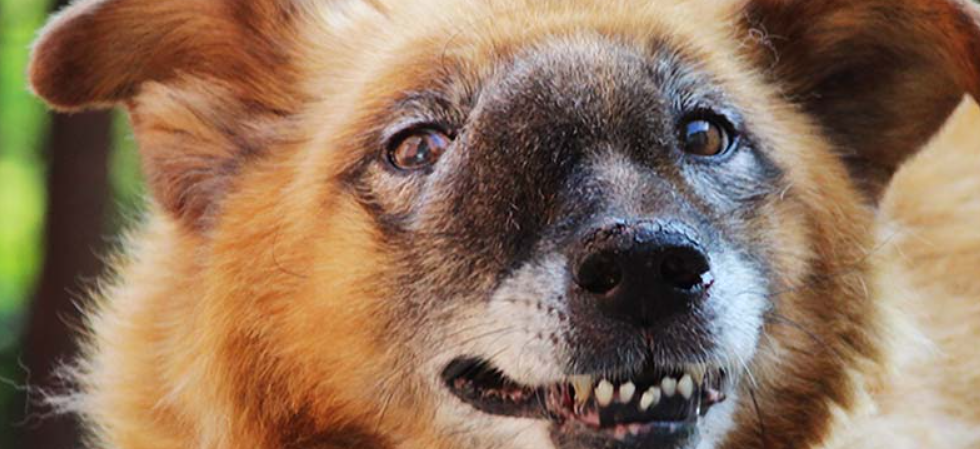
Common Nasal Tumor Types in Dogs
| Tumor Type | Typical Location | Growth Behavior | Response to Treatment | Notes |
| Adenocarcinoma | Nasal epithelium | Locally aggressive | Responds to radiation | Most common nasal tumor in dogs |
| Squamous Cell Carcinoma | Upper respiratory tract | Moderately aggressive | Poor surgical candidate | May ulcerate through nasal bones |
| Fibrosarcoma | Nasal connective tissue | Infiltrative | Limited response to chemo | Often occurs in younger dogs |
| Chondrosarcoma | Nasal cartilage | Slow but invasive | Fair response to surgery | May recur locally |
| Lymphoma | Diffuse nasal mucosa | Systemic involvement | Responds well to chemo | Often part of multicentric disease |
Identifying the tumor subtype helps shape the therapy strategy, as certain tumors like adenocarcinomas benefit most from radiation, while others such as lymphoma may respond to systemic chemotherapy. Understanding these distinctions also allows owners to anticipate the expected course of the disease and make informed decisions early.
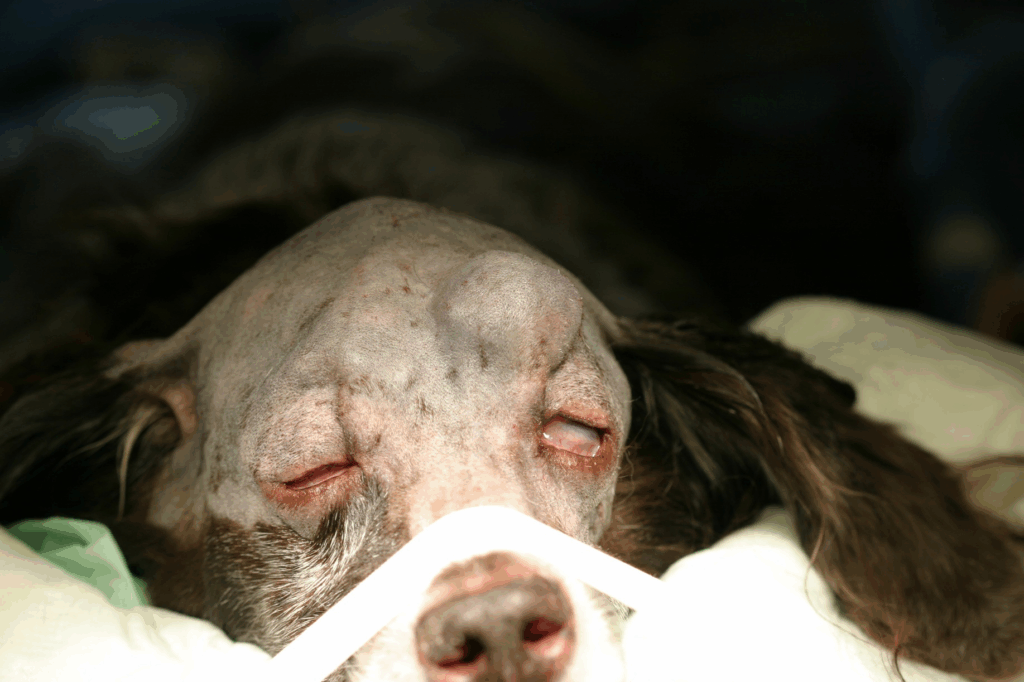
Prognosis and Expected Outcomes
The prognosis for dogs with nasal cancer varies based on tumor type, stage at diagnosis, and chosen treatment. Without treatment, survival time is often less than three months due to progressive nasal obstruction, bleeding, and neurological complications. However, with radiation therapy, many dogs live an additional 8–18 months, with improved comfort and reduced symptoms.
Surgical resection alone typically yields limited benefits due to the complexity of the nasal anatomy and high recurrence rates. Chemotherapy as a standalone treatment is rarely curative but may improve quality of life or control systemic disease in cases like lymphoma.
Much like in human medicine — for instance, pancreatic cancer, where early staging and aggressive treatment extend survival despite poor prognosis — identifying nasal tumors at Stage 1 or 2 offers the best chance at meaningful time extension and symptom control. Every week of delay in diagnosis reduces this therapeutic window.
Importance of Early Intervention
Timely treatment plays a pivotal role in managing nasal tumors in dogs. The narrow anatomy of the nasal passages means even small tumors can cause significant breathing difficulties, making early radiation or surgery more effective in preserving function.
Veterinary oncologists emphasize that once the tumor invades the orbit or cribriform plate, treatment becomes more palliative than curative. Early imaging, including advanced modalities like CT, is key to recognizing tumor boundaries before they breach critical areas.
This importance of acting quickly aligns with similar urgency in human oncology. As noted in our analysis of aggressive malignancies like lower eyelid cancer, when the tumor location is delicate and critical for function, timing defines outcome.
Managing Side Effects of Treatment
Radiation therapy, while the most effective option for nasal tumors in dogs, often causes local side effects that must be managed carefully. During treatment, dogs may experience nasal dryness, temporary fur loss, or mild inflammation around the face. In some cases, the skin over the nasal bridge can become irritated or ulcerated.
These side effects are usually manageable with topical medications and supportive care. Pet owners may be advised to apply cold compresses, use prescribed creams, or administer oral anti-inflammatory drugs to reduce discomfort. Most acute reactions resolve within a few weeks after treatment ends.
Long-term effects, such as fibrosis or changes in tear production, are rare but possible. These are typically outweighed by the benefits of tumor shrinkage and restored breathing function. Monitoring the dog’s appetite, energy levels, and facial comfort helps ensure the treatment remains humane and effective.
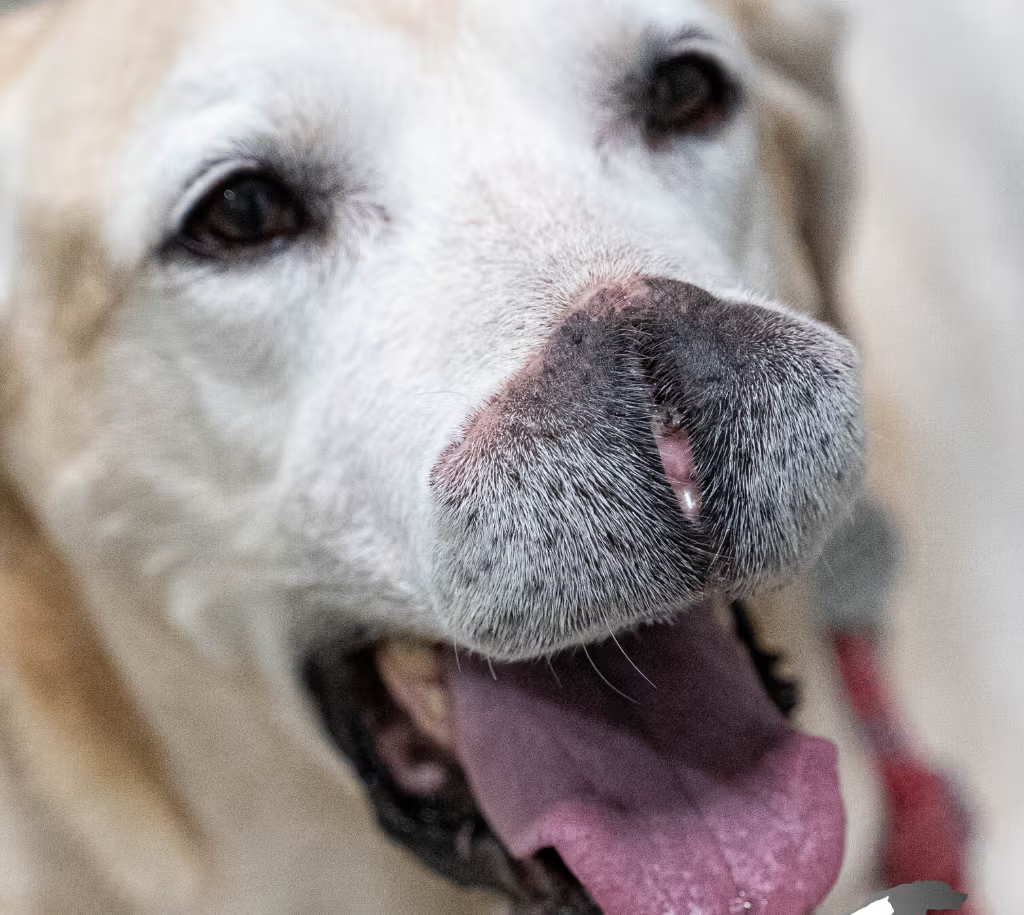
Supportive Care and Quality of Life
Beyond primary treatment, supportive care is essential for improving the daily comfort of dogs with nasal cancer. This includes pain management, antibiotics if secondary infections occur, and regular nasal irrigation or humidification to reduce congestion. Dogs with nasal bleeding may need to avoid physical exertion, rough play, or dusty environments.
Nutritional support is also critical, particularly in dogs with reduced appetite due to facial discomfort or difficulty smelling food. High-calorie, soft diets may be more acceptable. In advanced cases, feeding tubes or appetite stimulants might be considered to maintain body condition.
Owners play a central role in monitoring subtle signs like restlessness, nasal discharge changes, or reluctance to eat — all of which may signal tumor progression. Creating a calm, temperature-controlled environment helps reduce respiratory strain and improve sleep.
Just as in delicate facial cancers like lower eyelid cancer, where quality of life preservation is central to treatment planning, nasal tumors in dogs demand a similar balance between control and comfort.
Recurrence and Long-Term Monitoring
Even after successful initial treatment, nasal tumors in dogs carry a significant risk of recurrence. Local regrowth may occur within 12–18 months, especially if margins were close or the tumor was incompletely treated. Follow-up includes routine nasal exams, repeat imaging, and monitoring for new or worsening symptoms.
Re-irradiation is sometimes possible in selected cases, though risks increase with cumulative radiation dose. In most situations, recurrence management shifts toward comfort and palliative care rather than cure. Owners may be offered corticosteroids, pain relief, or even experimental therapies to slow progression.
It’s important to maintain realistic expectations. While early intervention can significantly extend life, most nasal cancers in dogs are ultimately fatal. The goal becomes maximizing time while minimizing suffering.
When to Euthanize a Dog with Nasal Cancer
Euthanasia is one of the most emotional and difficult decisions a pet owner may face, especially when dealing with a chronic and progressive illness like nasal cancer. This decision is rarely sudden — rather, it’s the endpoint of a gradual decline, marked by worsening symptoms, unmanageable pain, or complete loss of quality of life.
Veterinarians often guide owners using a quality-of-life scale, which assesses physical and emotional well-being across key domains: pain management, breathing comfort, appetite, hydration, hygiene, mobility, and social interaction. When a dog consistently scores poorly in several categories — for example, if it can no longer breathe comfortably even at rest, refuses food entirely, isolates from family members, or experiences frequent bleeding — this may be an indication that humane euthanasia is the most compassionate option.
Nasal tumors, particularly those that reach the cribriform plate or orbit, can cause significant facial pain, obstructive breathing, and distressing neurologic signs such as seizures or disorientation. While some dogs tolerate palliative care well for a time, others deteriorate rapidly. Open, early discussion with the veterinary team helps families prepare emotionally and practically for the right moment to say goodbye, ensuring the process is peaceful and dignified for the dog.
Alternative and Integrative Therapies
In addition to traditional treatments like radiation or surgery, many owners explore alternative therapies to support comfort and enhance their dog’s overall well-being. While these approaches are not curative, they can improve quality of life when used responsibly alongside primary veterinary care.
Acupuncture has shown promise in veterinary oncology for reducing pain, enhancing appetite, and promoting calm behavior. When administered by a certified veterinary acupuncturist, this technique may be especially beneficial in dogs who are no longer candidates for aggressive therapy but are still active and engaged.
Nutritional supplements such as omega-3 fatty acids, turmeric (curcumin), green tea extract, and medicinal mushrooms (like maitake or reishi) are sometimes used to boost immunity and reduce inflammation. However, these must be reviewed by a veterinarian to avoid potential interactions with medications.
CBD (cannabidiol) is also gaining popularity for managing chronic pain and anxiety. While evidence in dogs is still limited, many owners report improvement in sleep and relaxation. Ultimately, integrative care is about thoughtful, supervised additions that prioritize the pet’s comfort and preserve the owner’s bond with their dog.
The Owner’s Role in Daily Support
In many ways, the pet owner becomes the most important caregiver after a nasal cancer diagnosis. While the veterinary team provides diagnostics and treatment planning, it’s the owner who observes daily changes, manages medications, and adapts the home environment for comfort.
Monitoring subtle changes — such as the color and consistency of nasal discharge, shifts in breathing effort, or behavioral withdrawal — helps detect early signs of progression. For instance, if bleeding episodes become more frequent or the dog avoids eating due to facial sensitivity, these are red flags that should prompt a vet visit.
At home, practical measures like soft bedding, clean and cool air, elevated food bowls, and access to quiet, low-stress spaces help ease discomfort. A humidifier may reduce nasal dryness or congestion. Frequent, gentle cleaning of nasal discharge with damp gauze prevents skin irritation and infection.
Emotionally, dogs draw strength from routine and calm companionship. Continuing short walks (if tolerated), speaking softly, and engaging in gentle play or affection can all bring joy even in later stages of illness. Owners should not underestimate the power of presence and love in the dog’s daily life.
Misconceptions and Common Mistakes
One of the most damaging misconceptions about nasal cancer is that chronic nasal symptoms must be due to allergies, infections, or aging. As a result, many dogs are treated with repeated antibiotics or antihistamines for weeks or months, delaying referral for imaging or biopsy. By the time a tumor is found, it may be far advanced.
Another mistake is assuming that if the dog still eats, drinks, and wags its tail, things are stable. Dogs are incredibly resilient and may appear “normal” even while in moderate discomfort. Waiting for a total breakdown before acting often leads to rushed, stressful decisions.
Additionally, some owners pursue unproven “natural cures” in desperation, sometimes rejecting established treatments entirely. While supporting comfort with supplements or diet is understandable, skipping evidence-based therapy in early stages can close the window of opportunity for life-extending care.
Finally, misinformation online about cancer being “instantly fatal” can lead to premature euthanasia. With guidance and compassion, many dogs live fulfilling lives for months after diagnosis, enjoying time with their family — especially if supportive care is started early.
Final Thoughts: Balancing Hope and Realism
Nasal cancer in dogs is undoubtedly a difficult diagnosis. It presents late, progresses steadily, and requires a combination of medical intervention and emotional strength to manage. However, it is not a diagnosis without hope. Many dogs live beyond expectations when treatment is initiated early and guided by a team who values both medical success and quality of life.
From recognizing the first signs to making the heartbreaking decision about euthanasia, the journey demands education, communication, and a deep connection between the dog, the family, and the veterinary care team.
Above all, what defines success in the face of nasal cancer is not how long the dog lives, but how well they are supported in whatever time they have. Whether through curative intent or gentle palliative care, the priority is comfort, dignity, and the preservation of joy — no matter how many days remain.
FAQ
What causes nasal cancer in dogs?
The exact cause remains unclear, but suspected risk factors include long-term exposure to environmental toxins like cigarette smoke, urban air pollutants, and possibly chronic inflammation. Certain breeds with longer nasal cavities, such as Collies and Greyhounds, appear to be genetically predisposed.
What are the first signs of nasal cancer in dogs?
Early signs include persistent nasal discharge (often bloody), sneezing, noisy breathing, and facial swelling. As the tumor progresses, dogs may develop appetite loss, lethargy, or even neurological symptoms like seizures if the cancer invades the brain.
How is nasal cancer diagnosed in dogs?
Diagnosis typically involves physical examination, advanced imaging (CT or MRI), rhinoscopy, and biopsy. Only histopathological examination of tissue can confirm the type of tumor and determine its aggressiveness.
Is nasal cancer in dogs curable?
Complete cure is rare due to the tumor’s invasive location. However, early detection combined with aggressive treatment like radiation therapy can significantly improve survival and quality of life. In some cases, dogs can live over a year post-diagnosis with proper management.
What is the average survival time?
Without treatment, survival averages 2–3 months. With radiation therapy and supportive care, many dogs live 8–18 months, sometimes longer. Outcomes depend heavily on tumor type, stage, and the dog’s overall health.
Can surgery remove the tumor completely?
Surgical removal is challenging due to the nasal cavity’s complex anatomy. In many cases, surgery is used for biopsy or debulking rather than full excision. Radiation remains the most effective option for local control.
Does nasal cancer cause pain in dogs?
Yes, especially in later stages when the tumor exerts pressure on facial structures or invades the bones. Pain can be managed effectively with medications such as NSAIDs, opioids, or corticosteroids as part of palliative care.
How do I know if my dog is suffering?
Signs of distress include labored breathing, persistent nasal bleeding, facial deformity, refusal to eat, withdrawal, or signs of pain despite medication. If these symptoms persist or worsen, quality-of-life discussions with your vet are crucial.
Is euthanasia the only option in late-stage cancer?
While late-stage cancer is typically not curable, euthanasia is a compassionate choice when suffering becomes unmanageable. Many owners opt for palliative care first, but when comfort can no longer be maintained, humane euthanasia prevents unnecessary pain.
Can nasal cancer spread to other parts of the body?
Yes. While it is primarily locally invasive, advanced nasal tumors may metastasize to the lungs or brain. CT scans help assess the extent of spread and guide prognosis.
Is chemotherapy effective for nasal tumors?
Chemotherapy is not the primary treatment for most nasal tumors but may be used in cases like lymphoma or as an adjunct to radiation. Its effectiveness depends on tumor type and overall treatment goals.
Can dogs with nasal cancer still enjoy life?
Yes — with proper pain management, supportive care, and adapted routines, many dogs maintain a good quality of life for months after diagnosis. Regular check-ins and adjustments help ensure ongoing comfort.с
What happens if I do nothing?
Without treatment, nasal tumors continue to grow, leading to severe breathing difficulty, facial destruction, and eventual neurological compromise. In these cases, euthanasia is often needed within a few months to prevent prolonged suffering.
What should I ask my vet if my dog is diagnosed?
You should ask about the tumor type, staging, treatment options, prognosis, expected side effects, and when to consider palliative care. Understanding all options helps you make the most compassionate, informed decision for your dog.

